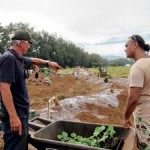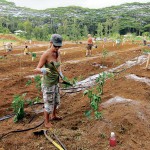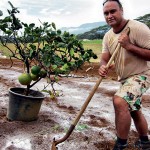Creating A North Shore Food Forest
Lots of people talk about Kaua’i becoming food independent, but at Kalihiwai a group of folks is actually doing something about it
Community members are walking the food-sustainability walk on the North Shore of Kaua’i.
Some 50 volunteers recently dug their hands into the dirt in Kalihiwai to create the island’s first self-sufficient Community Food Forest.
“There has been a lot of talk about sustainability, and very little effort to demonstrate what that would actually take to achieve in working and productive agricultural systems,” says Ray Maki of Permaculture Kaua’i, the project’s supervisor.
Mangoes, limes and bananas are just a few of the 88 different varieties of food trees to be planted on approximately 1.5 acres of land.
“People are working on faith here that the intention is to support the broader community,” says Malama Kaua’i executive director Keone Kealoha. “It’s taking the values and ideals of community and saying, ‘We can do it if we get together and work cooperatively and collaboratively.’ And that’s the only way this thing is working. Everybody’s bringing a little piece of something, and in the end it’s to share.”
Thousands of trees and carbon- and nitrogen-fixing plants are to be harvested with a permaculture approach that allows them to naturally work with the topography of the land and weather patterns. The organic forest, with the help of volunteer maintenance, will ultimately generate its own soil amendments, thereby creating an almost entirely self-sustaining forest.
In a typical orchard, only trees and grass might be planted. In this forest, however, a majority of what will be needed to feed the primary, climax tree species will come from companion plants throughout the intervening spaces.
“We could grow 100 percent of our food here on Kaua’i. However, if we are still importing 90 percent of our fertilizer and amendments, we are still dependent upon an import model of production,” says Kealoha, whose organization, along with Regenerations International Botanical Garden and the Sanctuary of LUBOF (Living in Universal Beauty as One Family), is responsible for the forest’s fruition. “Food self-sufficiency must rely on all aspects of the system to be localized.”
In addition, because everything will be planted in a way that works with the environment rather than against it, resources, including water, can be provided naturally in order to maintain the forest. For example, berms will collect rainwater and direct it to specific sites.
“Instead of running down the hill, it sits there and slowly percolates and waters everything below it,” explains Maki.
Nonetheless, since the land being cultivated was once a mineral-extracting plantation, the soil must undergo an initial preparation with certain amendments.
Also, other resources such as recycled cardboard are initially used for sheet mulching, sequentially suppressing weed growth.
Another sustainable method of the food forest’s implementation is the use of a wide variety of genetically diverse species.
“They may not be your typical plants you see at the supermarket or even normally grown on Kaua’i, but they are suited to the environment,” says Kealoha.
By having more diversity, such as many different species of bananas and avocados, the forest becomes less susceptible to pests and disease.
“Because if something happens, we want to be propagating backup species – new species that come in to help diversify the genetic pool of what’s available,” says Kealoha.
Eventually, the food forest will serve as a resource site for Kaua’i’s food plants. The propagation of seeds and creation of starts for distribution are some of the many long-term goals.
“We’re doing this initially as a demonstration site to understand what it takes to put this in and fine-tune it, and ideally we’d like to continue doing this around Kaua’i and engage other communities in their localities,” says Kealoha.
He reminds folks that the intention isn’t just to show up to eat.
“We share in the abundance of everything, including the work that it takes to get the food ready to eat,” says Kealoha.
“We’re serious about modeling this as a community-generated project,” notes Maki, adding the project is entirely volunteer- and donation-based. “We’d like to show how productive we can be.”
“Really it’s about food security and community-building in general through the use of food as the medium for people to come together,” says Kealoha. “We’ve all got to eat, so why don’t we eat together?”
- Ray Maki and Keone Kealoha discuss where the squash in the wheelbarrow should be planted for maximum self-sufficiency
- Mayor Bernard Carvalho Jr. shows his support for the Community Food Forest at Kalihiwai
- Volunteers help make the food forest a reality
- Malama Kaua‘i’s Keone Kealoha. Coco Zickos photos






